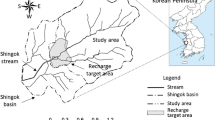Abstract
Because of a high population density in the coastal plain, any future nuclear power plants will be located in the sparsely settled Negev desert Since this part of Israel has no surface water, the only alternatives to cooling water are piped-in Mediterranean. Water and local, brackish groundwater One particular aquifier was examined for its potential to provide the required amount of cooling water over the lifetime of the plant, without causing a drastic lowering of the regional water table It was concluded that given the assumed range of aquifer properties, extraction of brackish water for cooling purposes will not result in large changes in the regional water table, furthermore, it could possibly halt the gradual deterioration of the quality of the water supply of the city of Beer Sheva
Similar content being viewed by others
References Cited
Arkin, Y., and M. Hamaoui, 1967, The Judea Group (Upper Cretaceous) in central and southern Israel. Geol. Surv. Isr. Bull. 42.
Gvirtzman, G., 1970, The Saqiye Group (Late Eocene to Early Pleistocene) in the coastal plain and Hashephela regions, Israel. Ph.D. Thesis, Hebrew University, Jerusalem (in Hebrew, with abstract in English).
Author information
Authors and Affiliations
Rights and permissions
About this article
Cite this article
Arad, A., Olshina, A. Brackish groundwater as an alternative source of cooling water for nuclear power plants in Israel. Environ. Geol. Water Sci 6, 157–160 (1984). https://doi.org/10.1007/BF02509909
Issue Date:
DOI: https://doi.org/10.1007/BF02509909




